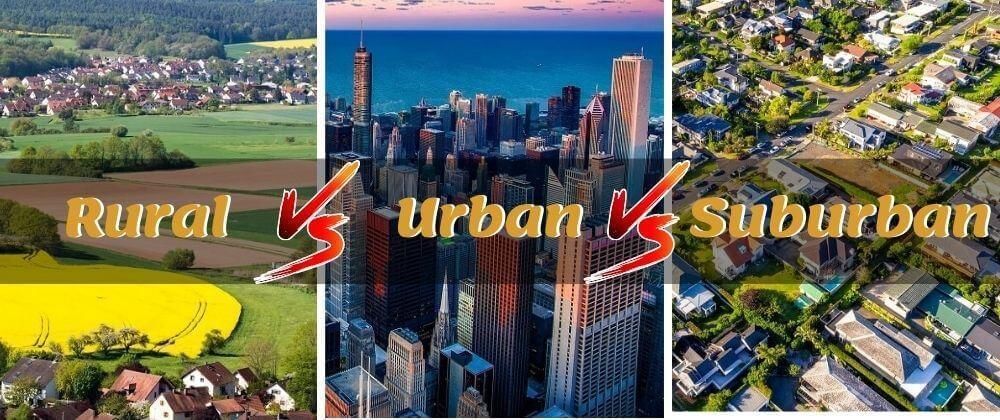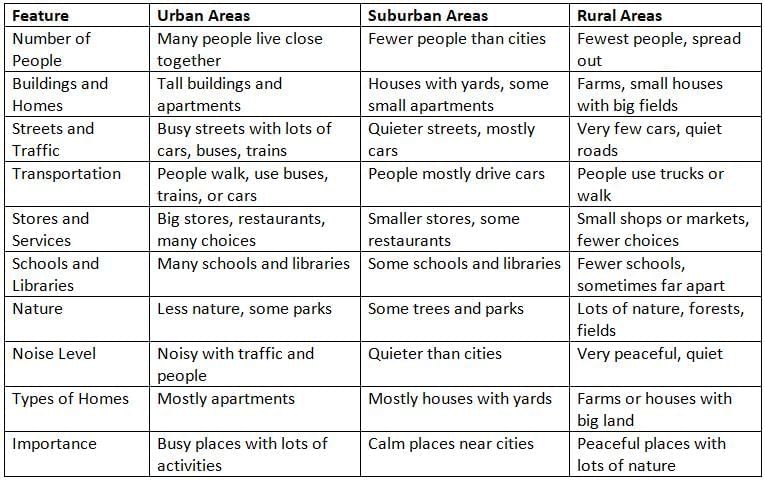Grade 2 Exam > Grade 2 Notes > Social Studies for Grade 2 > Chapter Notes: Human geography
Human geography Chapter Notes | Social Studies for Grade 2 PDF Download
| Table of contents |

|
| Introduction |

|
| Major U.S. Cities |

|
| Identify Urban, Suburban, and Rural Areas |

|
| Compare Urban, Suburban, and Rural Areas |

|
Introduction
Human geography is all about the places where people live, work, and play. It helps us understand how people make their homes in different kinds of places, like big cities, smaller suburbs, or quiet rural areas. In this chapter, we will learn about major cities in the United States, what makes urban, suburban, and rural areas special, and how these places are different from each other. Let’s explore the world of people and their homes!
Major U.S. Cities
A city is a place where many people live close together.
- New York City is one of the biggest cities in the United States. It has tall buildings called skyscrapers and many people from all over the world.
- Los Angeles is a city in California known for its sunny weather and places where movies are made, like Hollywood.
- Chicago is a city in Illinois with big parks, museums, and a lake called Lake Michigan nearby.
- Houston is a city in Texas where many people work in jobs related to space, like at NASA.
- Washington, D.C. is the capital city of the United States. The President lives here in the White House, and important government buildings are here too.
- Miami is a city in Florida with beaches and warm weather, where many people speak Spanish.
- Atlanta is a city in Georgia with a big airport and places where important history about equal rights happened.
- Boston is a city in Massachusetts with old buildings and schools, and it’s famous for the American Revolution.
- San Francisco is a city in California with a famous bridge called the Golden Gate Bridge.
- Seattle is a city in Washington known for its coffee shops and a tall tower called the Space Needle.
Identify Urban, Suburban, and Rural Areas

- Urban areas are places like big cities with lots of people and buildings.
- In urban areas, houses and buildings are very close together.
- Urban areas have busy streets with cars, buses, and sometimes trains.
- Suburban areas are places near cities but less crowded.
- In suburban areas, people live in houses with yards or small apartment buildings.
- Suburban areas have schools, stores, and parks, but they are quieter than cities.
- Rural areas are places far from cities with lots of open space.
- In rural areas, people might live on farms or in small houses with big fields.
- Rural areas have fewer buildings and more nature, like trees and animals.
- You can tell areas apart by how many people live there and what the place looks like.
Compare Urban, Suburban, and Rural Areas

The document Human geography Chapter Notes | Social Studies for Grade 2 is a part of the Grade 2 Course Social Studies for Grade 2.
All you need of Grade 2 at this link: Grade 2
FAQs on Human geography Chapter Notes - Social Studies for Grade 2
| 1. What are the main characteristics of urban areas? |  |
Ans. Urban areas are typically defined by their high population density and vast human-built features. They often include cities and towns where people live and work closely together. Urban areas have diverse amenities such as schools, hospitals, shopping centers, and public transportation, making them vibrant and bustling places.
| 2. How do suburban areas differ from urban and rural areas? |  |
Ans. Suburban areas are located on the outskirts of urban cities and are characterized by lower population density compared to urban areas. They often feature residential neighborhoods with single-family homes, parks, and schools. Suburbs provide a blend of urban and rural characteristics, offering a quieter lifestyle while still being close to city amenities.
| 3. What defines rural areas, and how do they compare to urban and suburban areas? |  |
Ans. Rural areas are characterized by open spaces, low population density, and fewer buildings and infrastructure compared to urban and suburban areas. They often consist of farmland, forests, and small communities. Rural areas usually have limited access to services and amenities, making them distinct from the busier urban and suburban environments.
| 4. Why is understanding the differences between urban, suburban, and rural areas important? |  |
Ans. Understanding these differences helps individuals and communities plan for housing, transportation, education, and healthcare needs. It also aids in addressing issues such as resource allocation, environmental impact, and community development. Recognizing the unique characteristics of each area can lead to better policies and improved quality of life for residents.
| 5. What are some examples of major U.S. cities that represent urban areas? |  |
Ans. Major U.S. cities that exemplify urban areas include New York City, Los Angeles, Chicago, and Houston. These cities are known for their large populations, diverse cultures, and extensive infrastructure, making them key hubs for business, education, and entertainment.
Related Searches














